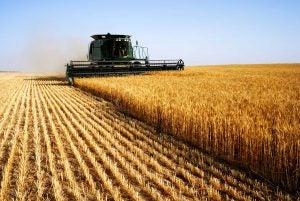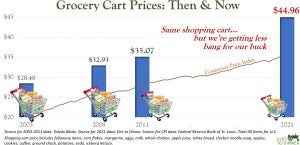Government data tells us we’re seeing the largest increases in inflation in years. It’s happening in all parts of our daily lives: apparel, vehicles, housing, insurance, transportation, recreation and entertainment, even raw materials — you name it, and you’re probably paying more than before. Needless to say, our food supply isn’t immune.
Dirt to Dinner decided to take a deeper look behind the Bureau of Labor Statistics‘ recent projection of a 2.2 percent increase in food costs in May, on top of a 3.5 percent increase the year before.
Just how much more expensive is our food?
The most immediate thing we learned was how complex the answer to those questions really are. No one or two simple causes are out there. Instead, it’s a complex mix of factors — some matters of macroeconomics, some of unique circumstances and situations, some of the changing demands placed on our food system both here in the United States and around the world. What’s more, it seems likely at least some of them will continue for a while to come. Let’s dig into the details behind the numbers, and see what we can learn and what we can do about it.
Inflation is all around us. The latest Consumer Price Index from BLS tells us prices have climbed by 5 percent year over year, the largest jump since 2008. Sharp rises in energy costs (29 percent) are a major factor behind that number, as anyone who filled a car with gas recently can likely attest.

The prices we pay for our food are right at the top of the list of greater expenses. On a global scale, the BLS numbers sound downright reasonable. The U.N. Food and Agriculture Organization recently estimated that the global Food Price Index has jumped 30.8 percent above last year’s figure, to its highest level since 2014. Higher costs for oils, meats, dairy, and cereal products all contributed to the rise — and the increasing worries about food insecurity that come with them.
That sobering picture makes the 2.2 percent number from BLS sound almost reasonable. But for anyone who does the daily shopping, the reality behind that innocent-sounding figure quickly gives way to an immediate and personal recognition of just how significant 2.2 percent can be — especially as part of a steady stream of superficially innocuous annual increases.
What’s making it more expensive?
Let’s look at some reasons for food price increases, from the big-picture perspective.
- The cornerstone commodities that provide the raw materials for our food are more expensive. Remember what you paid to fill your tank with gas a year ago? Wheat that sold for just one $5 per bushel one year ago today is near $7. Corn that sold for roughly $3 per bushel in August 2020 today is $6.85. Soybeans that were $8.33 in May of last year are almost $16 today.
- Demand for food and commodities is growing, and our supply of reserves is tighter than before. No one today needs to be reminded of the increases in global population and economic growth that fuel steady growth in food demand. What’s less well recognized is the narrowing gap between global food production and global consumption. The simple fact is, in the current environment we are drawing down our reserve stocks. And when strong demand meets shrinking supply, prices go up.
- Weather problems in key parts of the world add to the supply and demand imbalance, pushing prices up and increasing price volatility. Whether it’s climate change or normal weather cyclicality, some important growing regions around the world are experiencing record dry conditions in key production areas in South America, Russia, Australia, and the American West and Upper Midwest. Worries about crop sizes fuel a steady upward pressure on commodity prices.
- The cost of producing commodities is rising. The rapid run-up in energy costs has a profound effect on-farm costs. Diesel fuel for farm equipment, gas for vehicles, propane and natural gas to dry wet crops, even fertilizers — all contribute to higher production costs, which inevitably factor into the final prices paid by food consumers.
- Labor shortages complicate both farming and food manufacturing. Farmers and food manufacturers alike complain that they simply can’t find all the workers they need to cope with the current situation. And when they do, they often find they must pay more, if only to contend with the disincentives created by COVID relief payments. U.S. Department of Agriculture labor statistics indicates the number of workers hired by farmers and ranchers was down 11 percent from year-ago levels as recently as April, to about 613,000. The drop occurred despite an April increase of 6 percent over the previous April’s labor rates, to an average of $15.97 per hour.
- Supply chain disruptions add to costs. As if labor shortages and higher fuel costs for hauling commodities and delivering food products weren’t enough, our finely tuned food distribution system is still adjusting to yet another cycle of changes and interruptions in delivery channels. On a global scale, we’ve had to wrestle with complications in the location and availability of the ocean freight used to carry commodities around the world – not just what the United States exports, but also what we import to satisfy our food demands. Events such as the recent shutdown of the Suez Canal and the cyberattack that paralyzed JBS, the world’s largest meat producer, provide evidence of just how quickly and pervasively these disruptions can ripple across the entire food system.
- More out-of-home dining. The Covid pandemic led to a dramatic decline in the amount of food eaten out of the home, requiring our food system to adjust to moving a greater share of the food supply to retail channels. With the pandemic now appearing to ease, the system must once again adjust to a more traditional pattern. That means change to packaging, more complicated transportation logistics and a raft of other costly changes. BLS points out that the overwhelming proportion of the increase in food costs came from a run-up on prices for food eaten away from home — a whopping 4 percent, compared with 0.7 percent for food eaten at home. We’re going out to eat once again – and paying more for the privilege.
- Food waste remains an issue. We waste as much as a third of our food every day and every year. One online firm specializing in market data analysis estimates that about 1.6 billion tons of raw food products are never turned into consumable food to feed the hungry. Such waste only adds to the inflationary pressures of the big supply-demand picture.

We also need to remember that we may have been lulled into a touch of complacency about our food prices over the last decade. Food price inflation has been largely muted in recent years. Between 2013 and last year, for example, annual food price inflation averaged roughly 1.4 percent, with 2016 and 2017 both coming in with less than a single percentage-point rise.
Economists say the current inflationary prices eventually will ease. But few are willing to say when, or by how much. As our look at the causes of food price inflation showed, many of the factors driving up food costs are likely to be with us to one degree or another for some time to come.
But what does it all mean for me?
For most of us, the dizzying array of things that influence our food prices are less important than their immediate effect on our pocketbooks.
Dirt to Dinner decided to take a look at the real-world — or at least an admittedly unscientific glimpse of what the CPI data actually means to U.S. food consumers.

We asked our network of friends across the country to help us with an exercise that builds on some insightful and valuable work done by the Toledo Blade. That highly respected newspaper created a market basket of 15 common food items and tracked its cost in 2003, 2008 and 2011.
We elected to continue that work by seeking current price information for the same 15-item food basket, but with data from the Northeast, mid-Atlantic, deep South, upper Midwest, Gulf Coast, Mountain region, and West Coast.
Our results are intended to provide a simple snapshot of what food price inflation really means at the consumer level — not a rigorous, statistically reliable economic analysis. Our results show the cumulative effect of what may seem like small annual cost increases.
D2D invites readers to use the item checklist to take a closer look at what food inflation means for each of you.
The exercise taught us as consumers one very important lesson: shop smart.
We were surprised and pleased to see that the retail food industry seems to be doing its part to help consumers deal with rising food costs. We found numerous examples of sales and discounts for various items on the list, as well as some potential savings from house brands and locally sourced food items. In some cases, those savings helped reduce the overall basket costs significantly.
The bottom line
Economists, government officials, and other experts say the pace of inflation is likely to ease over time. But no one seems anxious to say exactly when that will occur, or by how much the rate of inflation may drop. But we do know that food price increases come from many causes and directions, and smart consumers will need to keep a careful eye on the food choices we make every day. We continue to spend about 10 percent of our disposable income on food at home and away — less than any other nation. Smart shopping can help us maintain that status.
Dirt to Dinner strives to help the public better understand how food is grown and processed, and why this is important. D2D also helps investigate the future of food and our global food system and explains how this system can be sustainable. A version of this article was originally published here.


